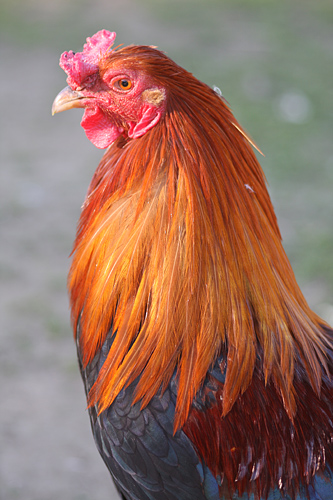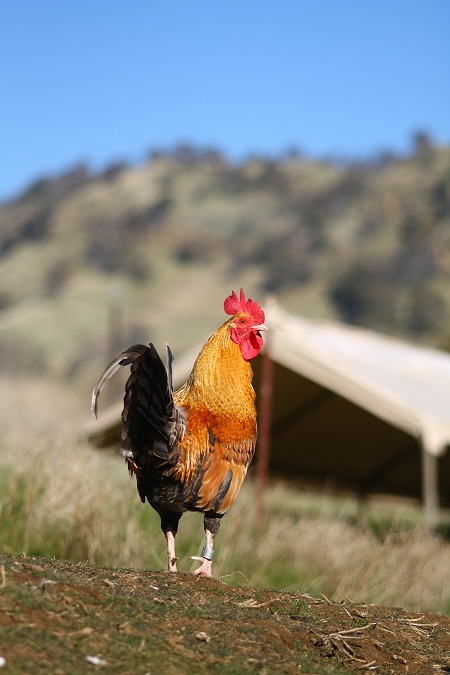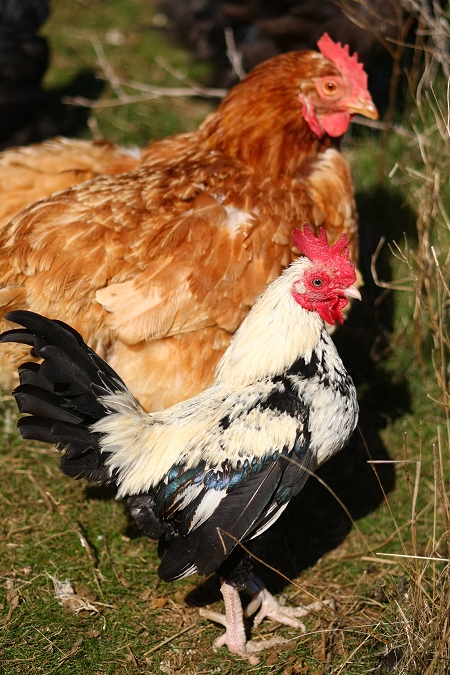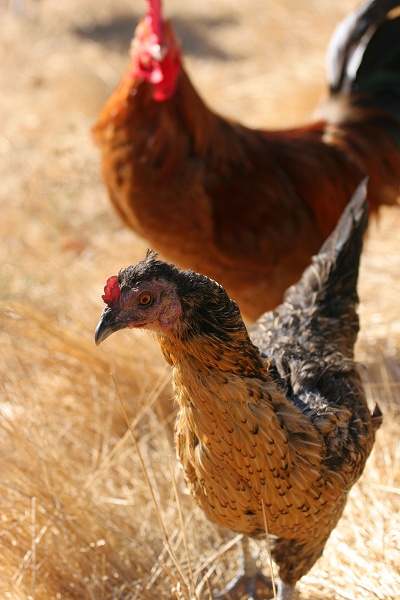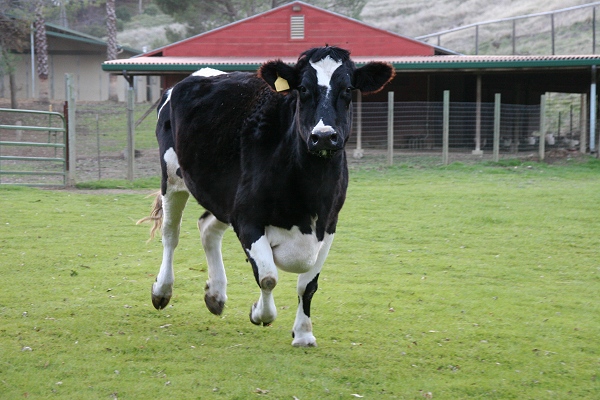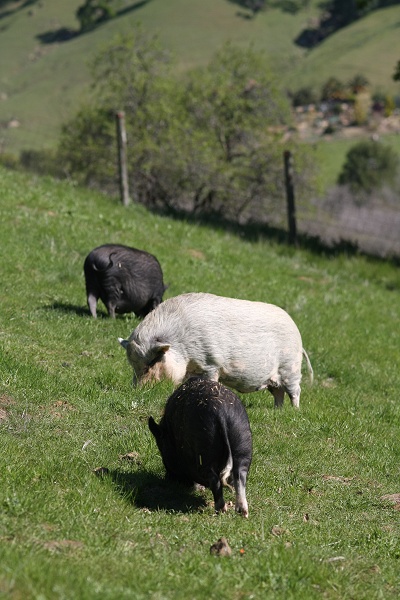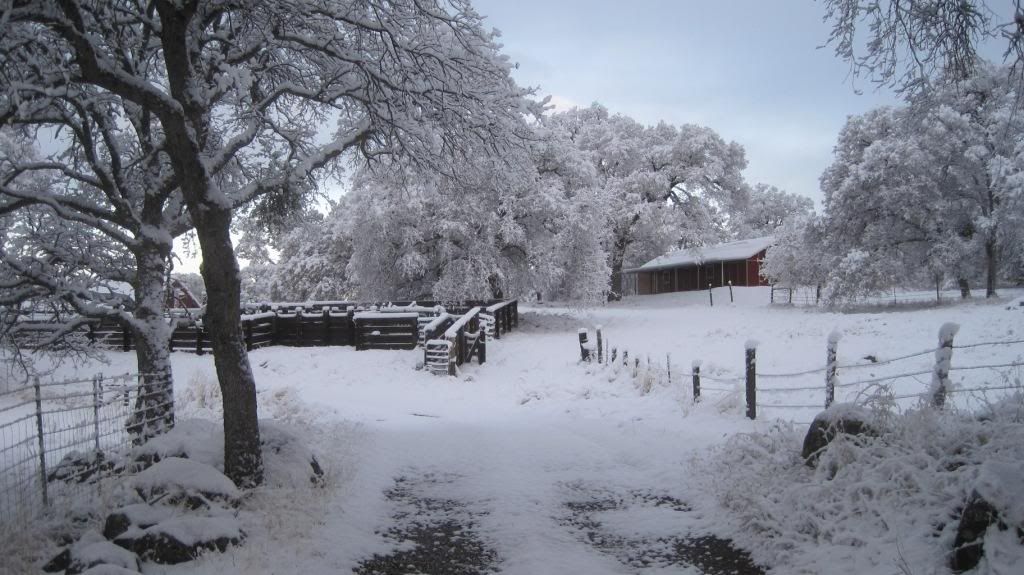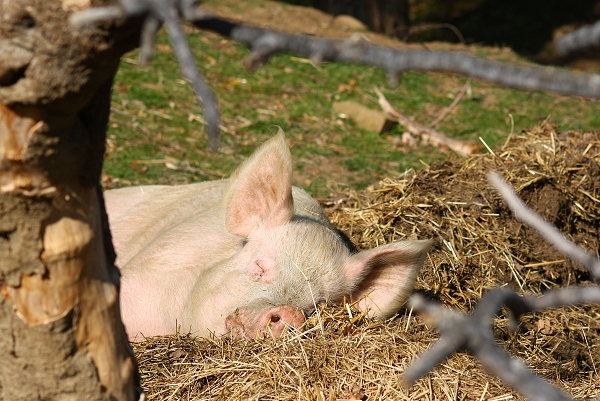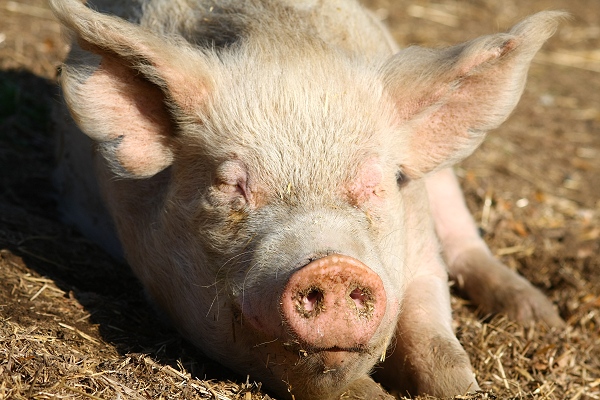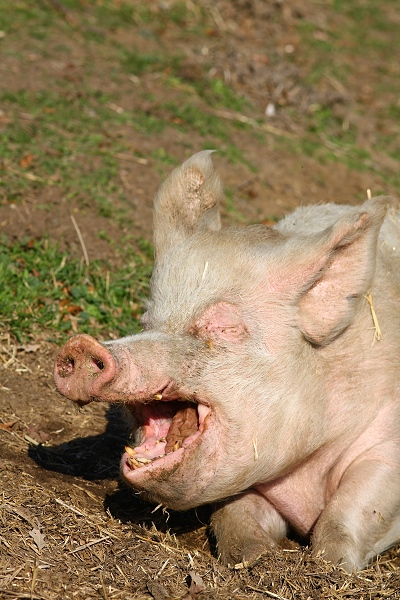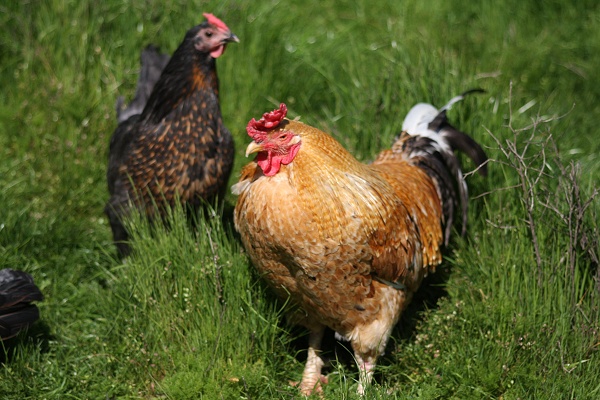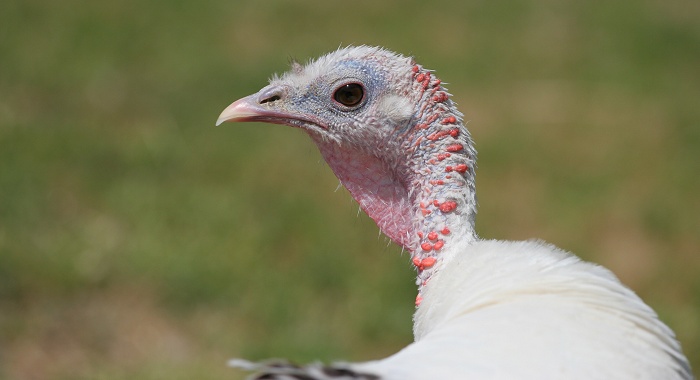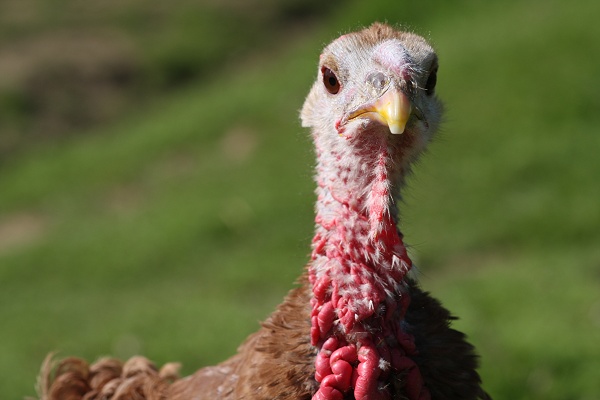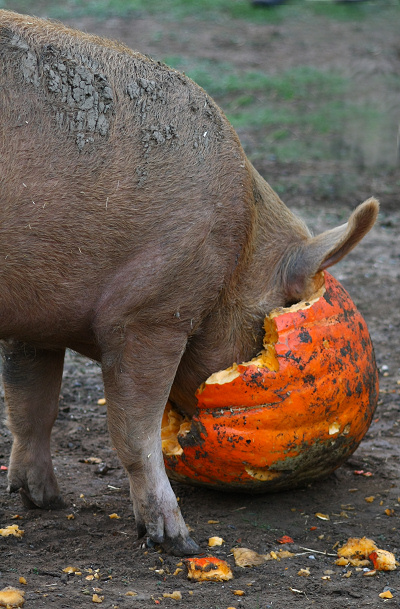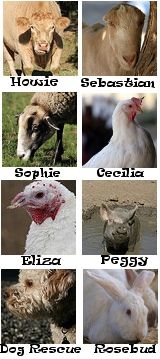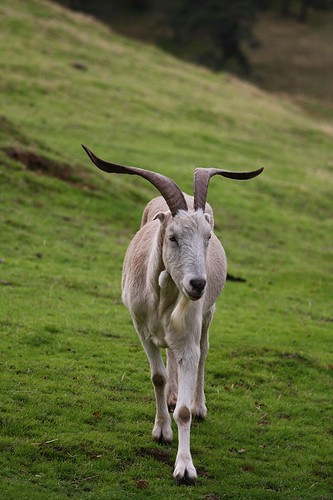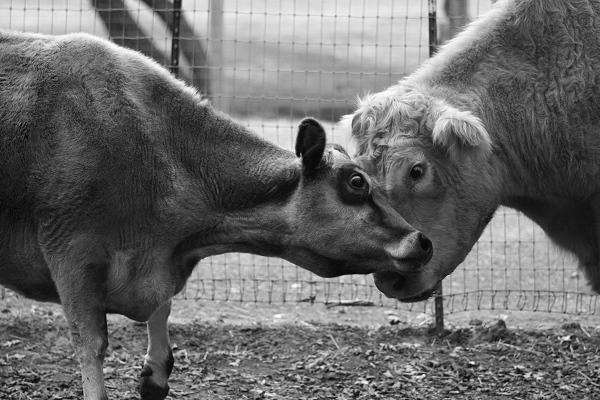Yet again, the victims of cruelty are killed by their supposed rescuers without given a fair chance at evaluation and placement. Seventy roosters found on an Earlville, Illinois property were killed on-site because "of the conditions they were in." The picture in this article shows a perfectly healthy rooster. The roosters were part of an illegal fighting and gambling operation.
I suppose I should be thankful that officials didn't do what Moore County, NC animal control officers did with 74 roosters, shooting them all in the head, painting them as vicious, dangerous animals. But I'm not. I'm tired of reading about roosters not even getting a reasonable chance at placement.
Here's the truth about roosters - they're individuals. They're smart. Once, I was trying to help place a woman's rooster because he had started to crow. She decided to use her dog training skills and clicker train the rooster not to crow. Guess what? Rooster now has a permanent home. Crowing is part-instinct, part-learned behavior. It's self-reinforcing, just like barking in dogs. Absent any other cues, a rooster can in fact learn to remain silent or, better yet, get his kicks by crowing on request/command (not at all hours or whenever the mood strikes). With proper management, this rooster won't face death and all because someone thought outside the box.
Roosters from fight-busts are not bent on world domination. Heck, many of them aren't even bent on killing all males within a 5-mile radius. Some are social, given enough space and freedom. Some are downright friendly, only fighting because of drugs, fear or desperation. Others are scrappers, quick to fight, quick to back down as well. Some will, in fact, hate other males all their lives. Some like humans, some are scared of people, others are defensive. All may initially be reactive amidst the stress of a fight-bust raid - I would hope anyone with a modicum of understanding on animal behavior gets that. Most can be trained not to kick or bite people, and some can even be taught better methods of expressing their dislike rather than fighting. I'm not trying to paint roosters as angelic beings who can co-exist with all other animals (humans included).I am trying to get us to stop thinking of them as automatons, robots with a penchant for blood, and start thinking of them as unique individuals with different temperaments and, in many cases, the ability to learn better behavior.
Sure, it's unreasonable to think seventy roosters can realistically find homes. It's hard finding homes for tiny bantam, fuzzy-feathered roosters, let alone large ones with such a sad history. I get that. But that is what we used to say about pit bulls from fight busts. It's too hard to find homes. They're too dangerous. They are genetically wired to kill. They can't get along with other animals. The reality is far different and it is tragically sad to think of the thousands of pit bulls who were never temperament tested, never given a reasonable chance at adoption or sanctuary in the past. It's also sad to think of the thousands of fight-bust roosters who have been shot, electrocuted, gassed or "humanely killed" as well. When homes or sanctuaries are available for fight-bust roosters, there should be no question as to what should happen to the bird. None.
Right now, though, we have to get shelters and authorities to even ask the question, to even open up to the possibility of placement. Few shelters are trying. These birds, who have endured so much tragedy, do not deserve to endure more at the hands of rescuers. All that I'm asking is they be given a fair, reasonable opportunity at placement. Nothing more, nothing less. It may mean the birds are still killed, but it also means not killing them the millisecond the cockfight ends and the "rescue" begins. It means some may get placed and it means setting a precedent that killing a healthy animal before they even step foot off of the fighting pit under the guise of "preventing suffering" doesn't happen anymore. If we are to be a compassionate shelter community, we can't kill rescued animals before they are even rescued.
Foggy Day
Everything is so much quieter when the fog rolls in, especially when it hangs around for the long haul.
It's noon out here and the fog hasn't left, choosing to partially obscure the sanctuary hilltops and shroud the valley in a cool mist.
The animals are mostly lying down, abstaining from making too much movement. The cattle chew cud noisily, surrounded by pink and red pigs who snore or graze contentedly on the grass.
Chickens and turkeys keep below the overhang, their avian murmer far quieter than normal.
The sheep look lovely on sheep hill, soft and cool. Fog hangs low behind them, a nice backdrop to their contented grazing. Lovely day at the sanctuary.
It's noon out here and the fog hasn't left, choosing to partially obscure the sanctuary hilltops and shroud the valley in a cool mist.
The animals are mostly lying down, abstaining from making too much movement. The cattle chew cud noisily, surrounded by pink and red pigs who snore or graze contentedly on the grass.
Chickens and turkeys keep below the overhang, their avian murmer far quieter than normal.
The sheep look lovely on sheep hill, soft and cool. Fog hangs low behind them, a nice backdrop to their contented grazing. Lovely day at the sanctuary.
Ringling Brothers abuses baby elephants
Ropes stretch taut, pulling a leg out from under a young elephant. She slams to the ground, a sharp hook jabbed into the sensitive back area of her head. Seven Ringling Brothers employees stretch the ropes further, splaying the baby animal's legs.When the elephant screams, trying desperately to sit up, a trainer uses an electric prod to keep her down.
And that is how Ringling Brothers teaches an elephant to lie down.
This method is only after the elephant has been chained, socially isolated, in the dark for nearly a month. Ringling Brothers has no interest in facilitating the learning process - they just want to break an animal as fast a possible so that they can make money from the stupid tricks. That's what they are too - stupid, dumb, inane, silly. They serve no purpose other than to entertain humans. Torturing animals, confining them in cages, beating, shocking....all for fun? That's wrong, immoral. Black and white, no fuzzy gray to see here.
You can see the photos here.They were taken by a former baby elephant trainer who's late wife pleaded with him to do what's right for the elephants. So a mere two months before his own death, Sam Haddock gave the photos to PETA who has published them for the world to see.
The Washington Post just published an in-depth article on this story here.
"It's not in Ringling's interest to mistreat the elephants. "These things are worth a tremendous amount of money. They're irreplaceable.'" This is Gary Jacobson, an elephant trainer. He also says elephants are a lot like people who are also apparently things. Seriously? Elephants are things? I suppose that makes beating them, shocking them, stealing them from their mothers, and making them perform stupid tricks all a lot easier. I mean, he's just doing it to a thing, right?
And that is how Ringling Brothers teaches an elephant to lie down.
This method is only after the elephant has been chained, socially isolated, in the dark for nearly a month. Ringling Brothers has no interest in facilitating the learning process - they just want to break an animal as fast a possible so that they can make money from the stupid tricks. That's what they are too - stupid, dumb, inane, silly. They serve no purpose other than to entertain humans. Torturing animals, confining them in cages, beating, shocking....all for fun? That's wrong, immoral. Black and white, no fuzzy gray to see here.
You can see the photos here.They were taken by a former baby elephant trainer who's late wife pleaded with him to do what's right for the elephants. So a mere two months before his own death, Sam Haddock gave the photos to PETA who has published them for the world to see.
The Washington Post just published an in-depth article on this story here.
"It's not in Ringling's interest to mistreat the elephants. "These things are worth a tremendous amount of money. They're irreplaceable.'" This is Gary Jacobson, an elephant trainer. He also says elephants are a lot like people who are also apparently things. Seriously? Elephants are things? I suppose that makes beating them, shocking them, stealing them from their mothers, and making them perform stupid tricks all a lot easier. I mean, he's just doing it to a thing, right?
Howie gets loved on
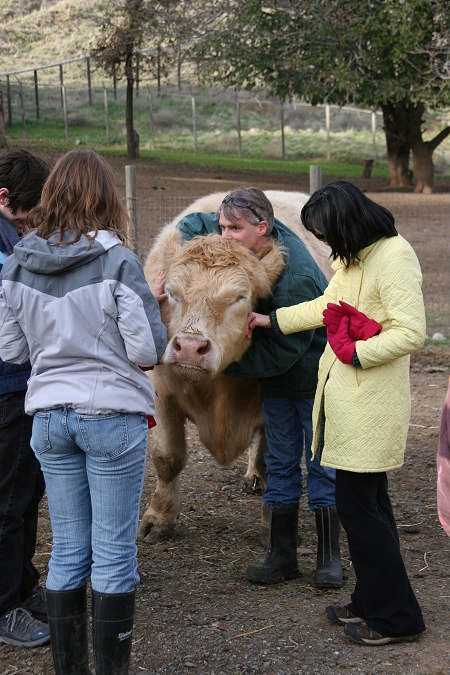 Last week, the Animal Legal Defense Fund (ALDF) came out for their holiday party. I tagged along for their tour and captured a couple of shots. Howie, the cherubic steer, was the most popular.
Last week, the Animal Legal Defense Fund (ALDF) came out for their holiday party. I tagged along for their tour and captured a couple of shots. Howie, the cherubic steer, was the most popular.Now, back in the day, this type of photograph wasn't possible with Howie. Even five years ago, Howie was a friskier animal, prone to random bursts of energy that often involved tossing wheelbarrows for sheer fun.
He aged and became a little arthritic and suddenly galloping madly towards humans wasn't such a fun idea. Instead of scaring people off, Howie finally gets to enjoy all of the attention he craves.
Backyard chicken redux
I was reading a Chicago Tribune blog whose author is irked by the recent release of a position statement on backyard chickens by the nation's leading farmed animal sanctuaries.
This is something that's been blogged here before. Animal Place currently opposes the creation of ordinances permitting chickens. We support and will promote the adoption of chickens into homes where they are legal.
Back to the blog, a point I'd like to touch upon:
As to roosters, the author fails to realize that it takes 4-6 months for purchasers to know gender. That's 4-6 months of children bonding with an engaging little bird, 4-6 months of Mary Sue naming, grooming, feeding and adoring her feathered friend. I cannot tell you how many calls we've received of crying mothers, sobbing chicken guardians who so desperately want to save their companion bird's life. When the gender is known, that rooster is suddenly taken from all that he has known, shuffled into a cold cage at the local shelter and, if he is lucky, he is euthanized properly by qualified staff.
The blog ignores entirely the valid issues the sanctuaries brought up. Nowhere does the author mention that day-old baby animals are shipped through the postal service without food for up to 72-hours legally. The author doesn't mention that hatcheries use roosters as packing material, you know, like bubble wrapper or newspaper, and then those same hatcheries refuse to take back the roosters. The author doesn't mention the increased intake shelters and sanctuaries have seen of unwanted hens and roosters, the difficulty in placing chickens, and the extra burden this places on animal shelters and sanctuaries.
The author doesn't mention that chickens are not uber-easy-throw-out-in-the-backyard pets. Their medical care is expensive. They are carriers of normal chicken diseases that people cringe at hearing - salmonella, coccidia, giardia. They attract rodents and predators, which can be prevented with proper predator proofing and extra care in storing food. The author doesn't mention that chickens are not food, they are unique individuals with interesting personalities. Goodness forbid, they are viewed as companion animals and, as such, be offered the kind of treatment a good guardian would provide to their dog or cat.
Animal Place will be opening Rescue Ranch sometime in 2010. It will serve as an innovative animal adoption and placement center. The focus will be farmed animals, especially chickens. Our goal will be to legally rescue hens from cooperating egg farms and place those caged and bedraggled hens into homes where they can run free, scratch in the dirt, sun-bathe, you know - be a chicken. We'll work tirelessly with shelters to place needy hens in homes and also focus on networking homes for the most neglected, the roosters. There are too many being slaughtered, too many being killed in shelters, too many being purchased and dumped. We want to see more hens and roosters adopted into good homes.
But we cannot, in good conscience, support opening the flood-gates for more abused and unwanted birds. Not until the regions where chickens ARE legal show they can significantly reduce the rate of unwanted hens and roosters, ensure birds are not slaughtered in backyards, and where most birds are adopted from organizations like Animal Place and not purchased from hi-volume, puppy-mill style hatcheries. And we certainly cannot support more ordinances when the perception of chickens is as food source and not companion. We want people to like chickens, relate to them as they would a companion dog or cat. We want people to revel in the daily gossip of the chickens. We want people to make that connection, between their companion chicken and the chicken wrapped in plastic at the supermarket - they are one in the same, an animal with unique interests, a drive to live.
If you are truly, honestly interested in welcoming chickens into your life as companions and friends, not as food sources, wonderful. Find out if it is legal where you live by contacting your planning department or local shelter. Research how to build a predator-proof chicken coop. Meet with neighbors, ask for input, answer questions and concerns. Remember, unhappy neighbors can lead to conflicts and problems. Make sure your fencing is tall and secure, able to prohibit access from raccoons, dogs, dangerous humans, wild cats, coyotes. Research the dietary needs of chickens - some breeds do poorly on a cobb-based diet, others do fine. Most love fresh produce. Learn where your local avian veterinarian is and find out how much a visit costs. Learn about the common diseases and health concerns with birds and how to prevent them.Make sure if you live in a cold-region you can keep the chickens warm.
And if you want to be put on a waiting list for incoming hens or roosters, or when Rescue Ranch is up and running - contact us at info@animalplace.org. We get calls frequently on needy chickens, especially roosters, so if you can legally provide a good, safe home for one, let us know. Please do not buy from hatcheries or feed stores. Please call us or your local shelter first and adopt. If you have questions on caring for chickens, email us as well - we're happy to help. With a flock of more than 100 chickens and turkeys and decades worth of experience handling birds, it's safe to say we've got a bit of expertise on the matter. :)
ETA: I think the commenters over at The Oil Drum offer up reasons aplenty for not allowing more ordinances.
This is something that's been blogged here before. Animal Place currently opposes the creation of ordinances permitting chickens. We support and will promote the adoption of chickens into homes where they are legal.
Back to the blog, a point I'd like to touch upon:
There is an assumption here that chickens people purchase from hatcheries and feed stores are somehow intended for egg farms. They aren't. There are hatcheries that produce hens for the egg-laying industry. A recent example is Hy-Line hatchery, the world's largest producer of hens for the egg industry and embryos for vaccines. They also grind up all male chicks alive, which isn't something hatcheries producing chicks for backyard flocks do - chicken sexing is difficult and roosters make great packing material.But isn't a life in a backyard with a concerned, if novice, family better than being debeaked, forced to molt and jammed into a tiny factory farm cage for your entire existence? And isn't a short life in that backyard better for a rooster than being liquidized in a grinder as a chick?
As to roosters, the author fails to realize that it takes 4-6 months for purchasers to know gender. That's 4-6 months of children bonding with an engaging little bird, 4-6 months of Mary Sue naming, grooming, feeding and adoring her feathered friend. I cannot tell you how many calls we've received of crying mothers, sobbing chicken guardians who so desperately want to save their companion bird's life. When the gender is known, that rooster is suddenly taken from all that he has known, shuffled into a cold cage at the local shelter and, if he is lucky, he is euthanized properly by qualified staff.
The blog ignores entirely the valid issues the sanctuaries brought up. Nowhere does the author mention that day-old baby animals are shipped through the postal service without food for up to 72-hours legally. The author doesn't mention that hatcheries use roosters as packing material, you know, like bubble wrapper or newspaper, and then those same hatcheries refuse to take back the roosters. The author doesn't mention the increased intake shelters and sanctuaries have seen of unwanted hens and roosters, the difficulty in placing chickens, and the extra burden this places on animal shelters and sanctuaries.
The author doesn't mention that chickens are not uber-easy-throw-out-in-the-backyard pets. Their medical care is expensive. They are carriers of normal chicken diseases that people cringe at hearing - salmonella, coccidia, giardia. They attract rodents and predators, which can be prevented with proper predator proofing and extra care in storing food. The author doesn't mention that chickens are not food, they are unique individuals with interesting personalities. Goodness forbid, they are viewed as companion animals and, as such, be offered the kind of treatment a good guardian would provide to their dog or cat.
Animal Place will be opening Rescue Ranch sometime in 2010. It will serve as an innovative animal adoption and placement center. The focus will be farmed animals, especially chickens. Our goal will be to legally rescue hens from cooperating egg farms and place those caged and bedraggled hens into homes where they can run free, scratch in the dirt, sun-bathe, you know - be a chicken. We'll work tirelessly with shelters to place needy hens in homes and also focus on networking homes for the most neglected, the roosters. There are too many being slaughtered, too many being killed in shelters, too many being purchased and dumped. We want to see more hens and roosters adopted into good homes.
But we cannot, in good conscience, support opening the flood-gates for more abused and unwanted birds. Not until the regions where chickens ARE legal show they can significantly reduce the rate of unwanted hens and roosters, ensure birds are not slaughtered in backyards, and where most birds are adopted from organizations like Animal Place and not purchased from hi-volume, puppy-mill style hatcheries. And we certainly cannot support more ordinances when the perception of chickens is as food source and not companion. We want people to like chickens, relate to them as they would a companion dog or cat. We want people to revel in the daily gossip of the chickens. We want people to make that connection, between their companion chicken and the chicken wrapped in plastic at the supermarket - they are one in the same, an animal with unique interests, a drive to live.
If you are truly, honestly interested in welcoming chickens into your life as companions and friends, not as food sources, wonderful. Find out if it is legal where you live by contacting your planning department or local shelter. Research how to build a predator-proof chicken coop. Meet with neighbors, ask for input, answer questions and concerns. Remember, unhappy neighbors can lead to conflicts and problems. Make sure your fencing is tall and secure, able to prohibit access from raccoons, dogs, dangerous humans, wild cats, coyotes. Research the dietary needs of chickens - some breeds do poorly on a cobb-based diet, others do fine. Most love fresh produce. Learn where your local avian veterinarian is and find out how much a visit costs. Learn about the common diseases and health concerns with birds and how to prevent them.Make sure if you live in a cold-region you can keep the chickens warm.
And if you want to be put on a waiting list for incoming hens or roosters, or when Rescue Ranch is up and running - contact us at info@animalplace.org. We get calls frequently on needy chickens, especially roosters, so if you can legally provide a good, safe home for one, let us know. Please do not buy from hatcheries or feed stores. Please call us or your local shelter first and adopt. If you have questions on caring for chickens, email us as well - we're happy to help. With a flock of more than 100 chickens and turkeys and decades worth of experience handling birds, it's safe to say we've got a bit of expertise on the matter. :)
ETA: I think the commenters over at The Oil Drum offer up reasons aplenty for not allowing more ordinances.
Welcome Patty (II)
Normally, we don't have two animals with the same name at the sanctuary. When an animal arrives with a name and seems to know that name, we certainly make exceptions.
Such is the case with Patty the cow. She should be very honored because her namesake, Patty the Pig, is the best pig ever.
Patty is 8-10 years of age. She first lived on a dairy farm but had trouble with pregnancy. This is generally a death sentence for dairy cows whose only worth is how many babies they birth and how much milk they produce. A veterinary teaching hospital ran some medical tests on Patty and determined she'd make a good blood donor cow.
Yes, they use other cows to provide blood to client animals. Summer may have received some of Patty's blood when he arrived at the hospital six months ago. She was used in this manner for six years. Recently, she got sick of it, the poking and prodding was too much and she wanted out of the blood donor business. Normally, an unruly donor cow would be sent to auction and slaughter....but as with most rescues, Patty had an advocate to champion her cause. A veterinarian who had fallen in love with the gentle cow worked tirelessly to save her life and that of two other donor cows (who have adoptive homes, yay). The teaching hospital acquiesced and, after months of cutting through red tape, Patty finally arrived home.
We let in Nicholas to keep her company and this calmed Patty down immediately. She's lived with other cows, so we couldn't possibly leave her by herself - cattle are incredibly gregarious, a lone cow is generally a stressed out, unhappy one.We'll keep her in this pasture, with Nick as company, for several days. This will help her identify the barnyard as "home base".
It's been interesting - the past two cows, Elsa and now Patty, have both been around people a lot. Elsa spent fifteen years being milked and handled by humans of all ages. When we asked if she liked people, the response was an immediate Yes! But it turns out Elsa didn't really like all of the handling she endured. It's more than just the novelty of new surroundings - Elsa now has choices. She can choose to approach us or choose to walk away from us. If she wants to let me scratch her neck, that's her choice. If she doesn't, she moves away. She chooses where she grazes (tragically far enough away that staff have to hike up hills to check on her every day). All these choices! Patty's experience has probably been even less positive with people, so it isn't surprising that she decides to keep her distance. I did scratch her neck, long upward strokes to simulate a cow's tongue, and she lowered her head contentedly. But mostly, she just wants to be left alone.
It's so nice to watch animals get the opportunity to think for themselves, make their own decisions!
Such is the case with Patty the cow. She should be very honored because her namesake, Patty the Pig, is the best pig ever.
Patty is 8-10 years of age. She first lived on a dairy farm but had trouble with pregnancy. This is generally a death sentence for dairy cows whose only worth is how many babies they birth and how much milk they produce. A veterinary teaching hospital ran some medical tests on Patty and determined she'd make a good blood donor cow.
Yes, they use other cows to provide blood to client animals. Summer may have received some of Patty's blood when he arrived at the hospital six months ago. She was used in this manner for six years. Recently, she got sick of it, the poking and prodding was too much and she wanted out of the blood donor business. Normally, an unruly donor cow would be sent to auction and slaughter....but as with most rescues, Patty had an advocate to champion her cause. A veterinarian who had fallen in love with the gentle cow worked tirelessly to save her life and that of two other donor cows (who have adoptive homes, yay). The teaching hospital acquiesced and, after months of cutting through red tape, Patty finally arrived home.
We let in Nicholas to keep her company and this calmed Patty down immediately. She's lived with other cows, so we couldn't possibly leave her by herself - cattle are incredibly gregarious, a lone cow is generally a stressed out, unhappy one.We'll keep her in this pasture, with Nick as company, for several days. This will help her identify the barnyard as "home base".
It's been interesting - the past two cows, Elsa and now Patty, have both been around people a lot. Elsa spent fifteen years being milked and handled by humans of all ages. When we asked if she liked people, the response was an immediate Yes! But it turns out Elsa didn't really like all of the handling she endured. It's more than just the novelty of new surroundings - Elsa now has choices. She can choose to approach us or choose to walk away from us. If she wants to let me scratch her neck, that's her choice. If she doesn't, she moves away. She chooses where she grazes (tragically far enough away that staff have to hike up hills to check on her every day). All these choices! Patty's experience has probably been even less positive with people, so it isn't surprising that she decides to keep her distance. I did scratch her neck, long upward strokes to simulate a cow's tongue, and she lowered her head contentedly. But mostly, she just wants to be left alone.
It's so nice to watch animals get the opportunity to think for themselves, make their own decisions!
Labels:
cattle,
dairy,
pictures,
rescues,
sanctuary life
Tell DailyCandy to remove mini pig gift selection
The DailyCandy is a popular site that connects readers to all that is supposedly chic in fashion, food and "culture".
Sadly, their 2009 Holiday Gift Guide for Girls includes a "present" that is anything but cool - miniature pigs.
Pigs can make wonderful companions, but no animal should be given as a gift without due consideration to his needs - pigs are not realistic companion animals for most people. You can read about the miniature pig phenomenon here. Royal Dandies are not a true breed of pig but an amalgam of different breeds, including one breed that can grow up to 400 lbs. It is interesting how few pictures of adult "RoyalDandies" exist.
Please help by asking DailyCandy to remove their suggestion of a "miniature pig" from their 2009 Holiday Guide for Girls. You can comment here (you'll have to start an account) or you can submit a email here.
Sadly, their 2009 Holiday Gift Guide for Girls includes a "present" that is anything but cool - miniature pigs.
Pigs can make wonderful companions, but no animal should be given as a gift without due consideration to his needs - pigs are not realistic companion animals for most people. You can read about the miniature pig phenomenon here. Royal Dandies are not a true breed of pig but an amalgam of different breeds, including one breed that can grow up to 400 lbs. It is interesting how few pictures of adult "RoyalDandies" exist.
Please help by asking DailyCandy to remove their suggestion of a "miniature pig" from their 2009 Holiday Guide for Girls. You can comment here (you'll have to start an account) or you can submit a email here.
Brrr! Grass Valley Sanctuary Hit with Snow
Some people look at this image and imagine themselves there, looking out onto the snow-flaked scene with a warm mug of cocoa in hands. Me, the pigs and chickens? No thank you!!!
This is the new bunny barn - the rabbits are pretty darn hardy and didn't blink an eyelash when shown this photograph. They were ready to frolick in that snow!
But when I showed the chickens their new barn, covered in the freezing snow, they were not impressed. They have actually demanded sweaters and space heaters.
The pigs too. They want fleece winter coats and warm mittens for their hooves. They don't do cold.
Cows, goats and sheep shrugged their shoulders - they are cold tolerant animals. What's 8-10 inches of snow between friends?
This is a good reminder for us still in Vacaville that we need to be cognizant of the fact that some of the species we rescue are not cold tolerant. While Grass Valley will be great for those same species in the summer, where temperatures are much cooler, the winter creates a whole new dilemma. We'll be looking into ways to keep the chickens and pigs extra warm during the cold, winter months.
We are, however, extremely excited to see how the animals react next winter when they step out of warm barns and into a winter wonderland! None of them have seen snow before, it should be a lot of fun.
(Do not tell my boss, but I will be calling in sick any day we have eight inches of snow, I'm with the chickens and pigs on this one!)
This is the new bunny barn - the rabbits are pretty darn hardy and didn't blink an eyelash when shown this photograph. They were ready to frolick in that snow!
But when I showed the chickens their new barn, covered in the freezing snow, they were not impressed. They have actually demanded sweaters and space heaters.
The pigs too. They want fleece winter coats and warm mittens for their hooves. They don't do cold.
Cows, goats and sheep shrugged their shoulders - they are cold tolerant animals. What's 8-10 inches of snow between friends?
This is a good reminder for us still in Vacaville that we need to be cognizant of the fact that some of the species we rescue are not cold tolerant. While Grass Valley will be great for those same species in the summer, where temperatures are much cooler, the winter creates a whole new dilemma. We'll be looking into ways to keep the chickens and pigs extra warm during the cold, winter months.
We are, however, extremely excited to see how the animals react next winter when they step out of warm barns and into a winter wonderland! None of them have seen snow before, it should be a lot of fun.
(Do not tell my boss, but I will be calling in sick any day we have eight inches of snow, I'm with the chickens and pigs on this one!)
All Grown Up!
Going through older photos, it's hard to believe how much some of the animals have matured (physically, at least).
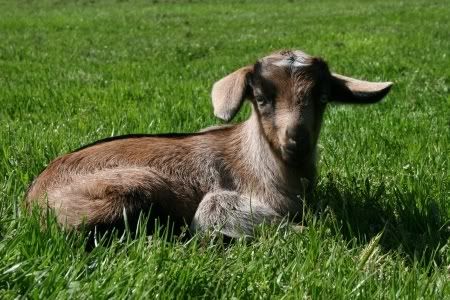 Behold, Jeffrey when he was but a wee kid. Like many young animals, his ears have no notion of proper placement. One has dreams of becoming a helicopter.
Behold, Jeffrey when he was but a wee kid. Like many young animals, his ears have no notion of proper placement. One has dreams of becoming a helicopter.
Everything about him is tiny.
Oh how things have changed in nearly three years!
He barely looks like the same goat! His dorsal stripe is the same, and the rather emo facial expression is still uniquely Jeffrey.
His ears have figured out where they should fall.
He also still whines like a baby kid. You will hear Jeffrey before seeing him.
Growing up for Jeffrey has been hard to do!
 Behold, Jeffrey when he was but a wee kid. Like many young animals, his ears have no notion of proper placement. One has dreams of becoming a helicopter.
Behold, Jeffrey when he was but a wee kid. Like many young animals, his ears have no notion of proper placement. One has dreams of becoming a helicopter.Everything about him is tiny.
Oh how things have changed in nearly three years!
He barely looks like the same goat! His dorsal stripe is the same, and the rather emo facial expression is still uniquely Jeffrey.
His ears have figured out where they should fall.
He also still whines like a baby kid. You will hear Jeffrey before seeing him.
Growing up for Jeffrey has been hard to do!
Labels:
goats,
pictures,
sanctuary residents
How to Photograph Pigs
Tally ho! But not to hunt foxes, because that is not how I roll. No, today is all about pigs. Floppy ears, bristled coats, sensitive snouts. All mine to share with you!
Pigs are difficult to photograph. Their floppy ears cast shadows across already small eyes. Humans like eyes, they like to empathize, see souls and all that jazz. Pigs are not visual creatures. They see through their nose, exploring the wafting scents the same way our eyes might scan a crowd for a friend. If you want to find a pig's soul, start at the snout. And when pigs are otherwise engaged in the fine art of eating, they have zero interest in lifting their heads for you to photograph. Grazing pigs can be quite lovely and the profile of a pig about to chomp on a 60lb pumpkin is immensely entertaining. But mostly pigs are snout to ground, searching for their next tasty morsel, portraits be damned.
I captured Patty mid-sit, an almost canine posture.
She has a grin on her face and gentle eyes. Her ears are correctly placed, allowing for proper viewing of, at the very least, one of her eyes. You can imagine the other one, it's a carbon copy of the right.
If you wake up a pig, they will sit like this and slowly, ever slowly, heave their large bodies up and begin their amble. Destination, you. Goal, belly rub.
Patty, I love. She is porcine perfection.
She ran me over after this photo. That is how she rolls.
Benjamin is busy snoring. He is too tired to lift his head, too groggy to even grunt a greeting. I would call him rude, but he is framed interestingly and wondrously pink.
He will not wake up for you, so please stop trying to be more important than beds of straw and pig-dreams.
Shhh, Susie is sleeping! Few animals sleep as beautifully as pigs, dogs maybe. They snooze in a way that makes you want to curl up next to their warm, soft bellies.
Susie is, hands down, the nicest pig. On earth, perhaps.
If you wake up Susie, you will be happy that you did.
No, Susie is not screaming. She is yawning - you have woke her up. It is imperative to yawn before getting up, clears the brain, gets you ready for the next step in your plan.
Susie yawns, a silent affair.
And then she is up. You will try to take pictures of her while she approaches, but you will fail. She will coo to you, soft greeting grunts. You will smile, grunt back and hope you're saying the right thing.
On some days, she will sniff you and move on. On most days, she will either dramatically fling herself at your feet or, as she did today, walk behind you and gently - CAREFULLY - spoon you. If you have not been spooned by a pig, you are missing out.
You will give her belly rubs, of course, and then you can lean against her tummy and observe the birds and the bees.
And then you can turn to your right and be faced with those big, floppy ears.
You can scratch behind them, or massage them, but mostly you will take pictures of them.
They are divinely beautiful - translucent bristles, pink flesh. You will never feed your dog one of these wondrously amazing appendages ever again.
And that, dear readers, is how you take pictures of pigs. Next year, when we are in Grass Valley, on 600 acres of rolling meadow, you should come see for yourself. The pigs will welcome your cameras, so longs as you scratch their bellies in return.
Pigs are difficult to photograph. Their floppy ears cast shadows across already small eyes. Humans like eyes, they like to empathize, see souls and all that jazz. Pigs are not visual creatures. They see through their nose, exploring the wafting scents the same way our eyes might scan a crowd for a friend. If you want to find a pig's soul, start at the snout. And when pigs are otherwise engaged in the fine art of eating, they have zero interest in lifting their heads for you to photograph. Grazing pigs can be quite lovely and the profile of a pig about to chomp on a 60lb pumpkin is immensely entertaining. But mostly pigs are snout to ground, searching for their next tasty morsel, portraits be damned.
I captured Patty mid-sit, an almost canine posture.
She has a grin on her face and gentle eyes. Her ears are correctly placed, allowing for proper viewing of, at the very least, one of her eyes. You can imagine the other one, it's a carbon copy of the right.
If you wake up a pig, they will sit like this and slowly, ever slowly, heave their large bodies up and begin their amble. Destination, you. Goal, belly rub.
Patty, I love. She is porcine perfection.
She ran me over after this photo. That is how she rolls.
Benjamin is busy snoring. He is too tired to lift his head, too groggy to even grunt a greeting. I would call him rude, but he is framed interestingly and wondrously pink.
He will not wake up for you, so please stop trying to be more important than beds of straw and pig-dreams.
Shhh, Susie is sleeping! Few animals sleep as beautifully as pigs, dogs maybe. They snooze in a way that makes you want to curl up next to their warm, soft bellies.
Susie is, hands down, the nicest pig. On earth, perhaps.
If you wake up Susie, you will be happy that you did.
No, Susie is not screaming. She is yawning - you have woke her up. It is imperative to yawn before getting up, clears the brain, gets you ready for the next step in your plan.
Susie yawns, a silent affair.
And then she is up. You will try to take pictures of her while she approaches, but you will fail. She will coo to you, soft greeting grunts. You will smile, grunt back and hope you're saying the right thing.
On some days, she will sniff you and move on. On most days, she will either dramatically fling herself at your feet or, as she did today, walk behind you and gently - CAREFULLY - spoon you. If you have not been spooned by a pig, you are missing out.
You will give her belly rubs, of course, and then you can lean against her tummy and observe the birds and the bees.
And then you can turn to your right and be faced with those big, floppy ears.
You can scratch behind them, or massage them, but mostly you will take pictures of them.
They are divinely beautiful - translucent bristles, pink flesh. You will never feed your dog one of these wondrously amazing appendages ever again.
And that, dear readers, is how you take pictures of pigs. Next year, when we are in Grass Valley, on 600 acres of rolling meadow, you should come see for yourself. The pigs will welcome your cameras, so longs as you scratch their bellies in return.
Gift basket - Win for the animals!
 DaisyWares is donating a gift basket worth $100 to raise funds for the rescue and care of the animals at the sanctuary. Veterinary costs have increased dramatically for us, and even the smallest of donations can help offset the cost.
DaisyWares is donating a gift basket worth $100 to raise funds for the rescue and care of the animals at the sanctuary. Veterinary costs have increased dramatically for us, and even the smallest of donations can help offset the cost. The gift basket includes:
2 soaps (Lavender & Chamomile)
2 perfumes (Fruity Fun & Strawberry)
1 mineral makeup eyeshadow in Australian Amber
1 Shea butter body cream
1 lip balm (Vanilla)
1 $10 gift certificate to Daisy Wares
2 pair of earrings (crystals are swavorski)
2 necklaces (swavorski crystals, aragonite beads with heart pendant)
Meet the new rabbit posse
Bunny Haven is officially closed for business after three new rabbits arrived! No more applicants will be accepted, this club is full. Tima was rescued from a school that had become a dumping ground for unwanted bunnies. Animals began breeding until the population swelled to more than a hundred. The school wanted to kill all of the rabbits, while rescue agencies wished to, you know, crazily enough rescue them. Thankfully, compassion won out and all of the rabbits were saved. Animal Place accepted three in August - Boris, Holly and Emily. Lucia and Larissa were rescued while roaming free. They belonged to someone who neglected and mistreated the rabbits, even threatening to slaughter them. Both are incredibly shy, so capturing them photographically was quite the challenge!
You can click the photos to see a larger version.
Tima
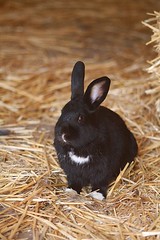

Larissa
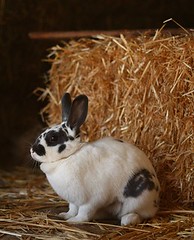

Lucia

You can click the photos to see a larger version.
Tima


Larissa


Lucia

Labels:
pictures,
rabbits,
rescues,
sanctuary residents
Arturo
On an online board somewhere out in the land of internets, there is a post about someone losing their chicken. Trust me, it's out there. And in the comment section, there is this - "It's only a chicken."
Not even a measly she or he, but the most distancing of pronouns - it.
Then there is the only a chicken part as if who we bond with must pass a litmus test, achieve something greater than the only a criteria. Only a dog. Only a cat. I've heard well-meaning people try to comfort the grieving parents of a lost infant by opining that, well, at least they didn't live long, didn't suffer long, or hey, you didn't put them through college or anything grandiose like that.Only a...
Grief is grief is grief. It's a living, breathing thing. It can be the soul-eating grief of losing a beloved, someone so near and dear to your heart that they might as well have taken up residence amongst ventricles. It can be the mind-numbing unexpected loss, the kind that takes your breath away, leaving you empty and drained. Sometimes it is a passing thing, strolling through uninvited, shaking you up.Other times it sits there, waiting for an opportune moment to rear its head, make you remember, make you feel. And that ache can happen no matter who you mourn for - a neighbor, a beloved dog, a parent or child, your best friend, even a perfect stranger. It's a strange thing, grief. Never an only a deal.
I present to you, Arturo:
Not even a measly she or he, but the most distancing of pronouns - it.
Then there is the only a chicken part as if who we bond with must pass a litmus test, achieve something greater than the only a criteria. Only a dog. Only a cat. I've heard well-meaning people try to comfort the grieving parents of a lost infant by opining that, well, at least they didn't live long, didn't suffer long, or hey, you didn't put them through college or anything grandiose like that.Only a...
Grief is grief is grief. It's a living, breathing thing. It can be the soul-eating grief of losing a beloved, someone so near and dear to your heart that they might as well have taken up residence amongst ventricles. It can be the mind-numbing unexpected loss, the kind that takes your breath away, leaving you empty and drained. Sometimes it is a passing thing, strolling through uninvited, shaking you up.Other times it sits there, waiting for an opportune moment to rear its head, make you remember, make you feel. And that ache can happen no matter who you mourn for - a neighbor, a beloved dog, a parent or child, your best friend, even a perfect stranger. It's a strange thing, grief. Never an only a deal.
I present to you, Arturo:
He is dead, no longer ruling leader of the chicken clan. I had a dream about him, flying over gates, spreading orange feathers gently over a small hen, cooing to his young, alive.So very alive.
Arturo was born at the sanctuary, a small fluffy creature, cheeping, calling, awaiting the day he too would be a big chicken. The hens loved Arturo. His mating ritual was a thing to behold, an intricate display of "rooster-ness" combined with gentleness. It is no wonder the hens liked him - he took his time, no "grab and go", nothing rough and tumble in the way he showed his love. He made it a point to interrupt the rougher roosters, shoving them bodily off of unhappy hens. He wouldn't take their place, only gently groom rumpled hens. I loved this about Arturo, a rare gem among roosters!
It was not like I was particularly close to him, I admired him from a distance. He rarely took a bad photo, and if he did, I'd never betray his secret. I loved how the other chickens would flock to him, watching him closely as he pecked in the grass or scratched in the dirt. When he would sun-bathe, flinging a wing dramatically out, at least three or four other birds would emulate. Yoga with Arturo, master of the Phoenix Sun Pose.
One day, seven baby birds emerged from the hills, trailing their mother. She had hidden her nest well, warming it every night, waiting for the perfect moment when tiny beak met shell and a new life emerged. While we cringed at adding seven birds to the flock, we marveled at these tiny lives, strutting, running, flitting from one spot to the next. As they aged, it was quite obvious who fathered them. Newman is large like Arturo but lacks his social graces, he is not a benevolent ruler. Arturo would not be proud. Kramer looks the most like Arturo with his speckled orange feathers. I am hoping he will turn out like his dad. And then there is Cosmos, who I am pretty certain is not Arturo's but that of Danny, a tiny Japanese bantam who had a secret rendez-vous with Cosmos' mother. All four hens look exactly like their mother, tiny, feisty, no-nonsense hens.
Arturo started to decline, hunched over more days than not. He would go up the hill a ways, crouched by himself. The day before he died, I watched a strange thing happen. More than a third of the birds walked up to where Arturo sat, uncomfortable. They surrounded him, several groomed him, and I had to run back to my office to grab a camera. Even the other roosters were coming up, keeping a respectful distance but not challenging him. I only caught a few of the birds surrounding him, but I think it speaks volumes about how important Arturo was to the flock. Even if they are crappy photos.
And then he was gone. Just like that, one day out there leading hens to prime dust-bathing spots, the next an Arturo-sized hole. I can't say the flock acted any different. I don't know whether chickens mourn, I like to think some do. I know they form bonds and make friends, along with enemies. They gossip all day long (Arturo never did, because he was kind like that). If some of the chickens did mourn, I did so right alongside them. He did not live as long as he should, though he lived every day gloriously and happily. A good life for only a chicken.
Happy Thanksgiving!!
Your ever-faithful blogger is blogging on her day off. This shows her true dedication to the cause of turkeys. Now I shall stop referring to myself in the third person and start posting pictures of turkeys. You can see some of the wild turkeys who live near the sanctuary in this blog's header. I caught that shot during a mating ritual in which all the tom turkeys were attempting to woo the same turkey hen. She laughed at them all. Seriously.
Please take heart, my fellow turkey lovers. This post is for you. Print it out or drag the computer around with you, especially if the dinner table is not so kind to our turkey friends. These turkeys are lucky and happy and chowing down on food as we speak. Celebrate them. Honor them. Feel gratitude and compassion to everyone, from the suffering turkeys to the liberated mink to the oppressed people in far off lands. Think of them all for one brilliant moment and do your best to love them all.
More specifically, you may love the following:
Miss Margaret who is shiny and perfect and who affixes you with a patently perfect turkey stare. She is five and in the prime of her life, according to her anyways.
Her see-through wattle dangles precariously from the softest neck you will ever have the pleasure of stroking (no dirty thoughts, please!). She has bumps and brilliant white feathers. And she hates Maya next door. A lot.
Oh Maya, how you coo and trill and scream what can only be turkey insults at MaryLou next door. You do not like her. At all. Sometimes you fly into their house next door just to taunt and prance and puff you feathers up in displays of anger. You do not peck, merely display. MaryLou does not like it one bit, though. We shoo you back to your rightful spot, you with squawks of indignation, MaryLou with trumpeting trills of victory!
MaryLou, MaryLou, MaryLou! You are so serious, lighten up! Enjoy the sunshine and green, verdant grass.
Stop staring at me with your serious eyes, your baleful glare will not make me sympathetic. It will actually, but I will not admit to such things.
You are groomer extraordinairre. Sometimes you groom me, the chickens, the other turkeys. Mostly, you groom yourself. Digging deep into the furrows of you feathers, sliding beak up and down, pulling oils and spreading them across great expanses of feathered valleys and mountains. You are the zen master of feather cleaning.
Willow, perfect, greedy, rude, angry, happy Willow! Do not tell any of the others, but you are my favorite. You are not personable. You are not overjoyed to see me or anyone else. You are grumpy and so very serious. Each day is onerous for you, a time to puff up your feathers and scream at the other turkeys and chickens. Peck! A startled hen goes flying. Snap! A rooster runs away in horror. You laugh at it all, proud of your bad attitude. I love you for it.
Eliza! Our resident "foster turkey" - you represent all of the turkeys not so lucky to make it to a sanctuary. You take the nesting behavior to a whole new level, dedicating your body, mind and soul to that one infertile egg. You love when one of your chicken friends nests with you, sometimes all we see of you is jumbled feathers, chicken feet perched on your back, or a chicken head poking happily out from under your breast. You hiss and shrilly trill when any of us get too close to your precious package or chicken friend. Nesting is serious business.
And then there is Zarriah and Serena, two old-lady turkeys with extremely shy personalities. They turn ten this year. And there was Leland too - he died this year, but his beauty and big personality live on. Tom turkey died soon after Leland, his best bud forever. We miss both of you.
Happy Thanksgiving from all the turkeys at Animal Place!
Please take heart, my fellow turkey lovers. This post is for you. Print it out or drag the computer around with you, especially if the dinner table is not so kind to our turkey friends. These turkeys are lucky and happy and chowing down on food as we speak. Celebrate them. Honor them. Feel gratitude and compassion to everyone, from the suffering turkeys to the liberated mink to the oppressed people in far off lands. Think of them all for one brilliant moment and do your best to love them all.
More specifically, you may love the following:
Miss Margaret who is shiny and perfect and who affixes you with a patently perfect turkey stare. She is five and in the prime of her life, according to her anyways.
Her see-through wattle dangles precariously from the softest neck you will ever have the pleasure of stroking (no dirty thoughts, please!). She has bumps and brilliant white feathers. And she hates Maya next door. A lot.
Oh Maya, how you coo and trill and scream what can only be turkey insults at MaryLou next door. You do not like her. At all. Sometimes you fly into their house next door just to taunt and prance and puff you feathers up in displays of anger. You do not peck, merely display. MaryLou does not like it one bit, though. We shoo you back to your rightful spot, you with squawks of indignation, MaryLou with trumpeting trills of victory!
MaryLou, MaryLou, MaryLou! You are so serious, lighten up! Enjoy the sunshine and green, verdant grass.
Stop staring at me with your serious eyes, your baleful glare will not make me sympathetic. It will actually, but I will not admit to such things.
You are groomer extraordinairre. Sometimes you groom me, the chickens, the other turkeys. Mostly, you groom yourself. Digging deep into the furrows of you feathers, sliding beak up and down, pulling oils and spreading them across great expanses of feathered valleys and mountains. You are the zen master of feather cleaning.
Willow, perfect, greedy, rude, angry, happy Willow! Do not tell any of the others, but you are my favorite. You are not personable. You are not overjoyed to see me or anyone else. You are grumpy and so very serious. Each day is onerous for you, a time to puff up your feathers and scream at the other turkeys and chickens. Peck! A startled hen goes flying. Snap! A rooster runs away in horror. You laugh at it all, proud of your bad attitude. I love you for it.
Eliza! Our resident "foster turkey" - you represent all of the turkeys not so lucky to make it to a sanctuary. You take the nesting behavior to a whole new level, dedicating your body, mind and soul to that one infertile egg. You love when one of your chicken friends nests with you, sometimes all we see of you is jumbled feathers, chicken feet perched on your back, or a chicken head poking happily out from under your breast. You hiss and shrilly trill when any of us get too close to your precious package or chicken friend. Nesting is serious business.
And then there is Zarriah and Serena, two old-lady turkeys with extremely shy personalities. They turn ten this year. And there was Leland too - he died this year, but his beauty and big personality live on. Tom turkey died soon after Leland, his best bud forever. We miss both of you.
Happy Thanksgiving from all the turkeys at Animal Place!
Resources - Antibiotics
Animal Place is compiling resources on farmed animals, from antibiotic-resistance to behavior to environmental degradation. This post includes information on antibiotic resistance and its ties to the use of antibiotics in animal agriculture. Posting these resources does not indicate endorsement of authors, organizations or all the content therein. This is not meant to be a definitive list.
If you have suggestions on other links related to antibiotic resistance and livestock, please feel free to leave us a message in the comment section.
The American Society of Microbiology
Antibiotic Resistance: An Ecological Perspective on an Old Problem
.pdf or executive summary
MRSA found in poultry
Johns Hopkins
Farmacology
The Farm/Food/Health Connection (powerpoint presentation, general)
Fate of antimicrobial-resistant bacteria in stored poultry litter
Environmental Health Perspectives
Antibiotic Resistance in Livestock - more at stake than steak
.pdf or pubmed entry
Health Observatory
Antibiotic Use in US Aquaculture
Food and Agriculture Organization of the United Nations
Antibiotic Growth Promoters in Livestock
Responsible Use of Antibiotics in Aquaculture
Antibiotic Use in Aquaculture and Antimicrobial Resistance
United States Department of Agriculture
Antimicrobial Drug Use and Veterinary Costs in U.S. Livestock Production
World Health Organization
Use of antimicrobials outside human medicine
Center for Science in the Public Interest
Antibiotic Resistance and Animal Agriculture Fact Sheet
Rodale Institute
Water, antibiotics and "Animal Farm"
Science Daily
MRSA Found in Swine Workers, Pigs
Poultry Consumption, Handling are Risk Factors in Antibiotic Resistance in Humans
Spreading Antibiotics in the Soil Affects Microbial Ecosystems
Routine Feeding of Antibiotics to Livestock May be Contaminating the Environment
University of Minnesota
Antibiotic losses in runoff and drainage from manure-applied fields
The Pew Charitable Trust
Antibiotic resistance in humans
TIME
Getting real about the high price of food
Environmental Health News
Crops absorb livestock antibiotics
If you have suggestions on other links related to antibiotic resistance and livestock, please feel free to leave us a message in the comment section.
The American Society of Microbiology
Antibiotic Resistance: An Ecological Perspective on an Old Problem
.pdf or executive summary
MRSA found in poultry
Johns Hopkins
Farmacology
The Farm/Food/Health Connection (powerpoint presentation, general)
Fate of antimicrobial-resistant bacteria in stored poultry litter
Environmental Health Perspectives
Antibiotic Resistance in Livestock - more at stake than steak
.pdf or pubmed entry
Health Observatory
Antibiotic Use in US Aquaculture
Food and Agriculture Organization of the United Nations
Antibiotic Growth Promoters in Livestock
Responsible Use of Antibiotics in Aquaculture
Antibiotic Use in Aquaculture and Antimicrobial Resistance
United States Department of Agriculture
Antimicrobial Drug Use and Veterinary Costs in U.S. Livestock Production
World Health Organization
Use of antimicrobials outside human medicine
Center for Science in the Public Interest
Antibiotic Resistance and Animal Agriculture Fact Sheet
Rodale Institute
Water, antibiotics and "Animal Farm"
Science Daily
MRSA Found in Swine Workers, Pigs
Poultry Consumption, Handling are Risk Factors in Antibiotic Resistance in Humans
Spreading Antibiotics in the Soil Affects Microbial Ecosystems
Routine Feeding of Antibiotics to Livestock May be Contaminating the Environment
University of Minnesota
Antibiotic losses in runoff and drainage from manure-applied fields
The Pew Charitable Trust
Antibiotic resistance in humans
TIME
Getting real about the high price of food
Environmental Health News
Crops absorb livestock antibiotics
Vegan Thanksgiving
I count myself one of the lucky, every Thanksgiving for the past few years has been vegan. No more worries over how I should react when the body came out. No more gag reflex responses every time someone mentioned how tasty that body was.
Sadly, this is not true for most people. I can't offer any advice, either. I was not a graceful vegan in the presence of a dead turkey on the Thanksgiving table. My strong sentiment is that, this one day a year, everyone could show a real ounce of gratitude and compassion by not killing any animal. Which ise fine to think, but I often accompanied these thoughts with, you know, actual words and stuff. Grumpy vegans are no fun. But hey, neither is watching a once-beautiful bird's body get stuffed into people's faces.
I've compiled a list of links to various recipes that might prove useful for next week's holiday. FARM has a nice little guide to the holidays for both you veggie loving fiends and those of the omnivorous persuasion.
There are a lot of alternatives to an actual turkey. You can purchase them commercially or make them yourself. These are all turkey approved, by the way. They'd eat these roasts up like they were going out of style.
Obviously this isn't a complete menu for your holidays. I hope your Thanksgiving is cruelty-free and full of awesomeness!
Tofurky - Not all vegans like this stuff, to which I say PIFFLE! You can buy the roast or a complete meal (sorta) with dumplings, gravy, stuffing and a wishstix (going all crazy with the funny spellings again). Tofurky gravy is the best commercial gravy. Ever. That's just a fact, and you may try to dispute it, but you cannot with me as your audience.
Celebration Roast - Get your salty-celebration on with this tasty roasty grainy goodness.
Gardein Veggie Turkey with stuffing - I haven't had this stuff yet, but I'm all over Gardein products like vultures on carrion!! That's a gross analogy, but vultures really like their carrion and I really like Gardein products, but I'm decidedly more classy when I'm eating their products. Not that vultures aren't classy. The only reason I bring up vultures is because I read an article about vultures taking over a town and residents afraid these nonviolent birds were going to EAT THEIR CHILDREN. They are turkey vultures, and we're talking turkeys and such here. There's my logic.
Make your own Tofu Turkey Roast - there's like five million comments to assist or distract. I've never made this, because I'm all for other people making my food. Just kidding about that.
Cider marinated tofu turkey (OH MY GOSH IT IS CUTE, LOOK AT IT NOW!)
Celebration Pot pie
Sides
Green bean mushroom casserole
Roasted butternut squash
Spiced cranberry sauce
Homemade vegan stuffing
Roasted garlic mashed potatoes
Mashed sweet potatoes with coconut milk
Desserts
You could totally be as awesome as Owen here with his whole head in a giant 60 pound pumpkin. Or you could be lame and make a dignified pie or something. Whatever makes you happy, right?
Pumpkin Pie
Pumpkin Pie bites
Autumn pumpkin spice cookies
Frangipane Pear Crostata
Chocolate cheesecake
Cranberry Walnut Tart
Sadly, this is not true for most people. I can't offer any advice, either. I was not a graceful vegan in the presence of a dead turkey on the Thanksgiving table. My strong sentiment is that, this one day a year, everyone could show a real ounce of gratitude and compassion by not killing any animal. Which ise fine to think, but I often accompanied these thoughts with, you know, actual words and stuff. Grumpy vegans are no fun. But hey, neither is watching a once-beautiful bird's body get stuffed into people's faces.
I've compiled a list of links to various recipes that might prove useful for next week's holiday. FARM has a nice little guide to the holidays for both you veggie loving fiends and those of the omnivorous persuasion.
There are a lot of alternatives to an actual turkey. You can purchase them commercially or make them yourself. These are all turkey approved, by the way. They'd eat these roasts up like they were going out of style.
Obviously this isn't a complete menu for your holidays. I hope your Thanksgiving is cruelty-free and full of awesomeness!
Tofurky - Not all vegans like this stuff, to which I say PIFFLE! You can buy the roast or a complete meal (sorta) with dumplings, gravy, stuffing and a wishstix (going all crazy with the funny spellings again). Tofurky gravy is the best commercial gravy. Ever. That's just a fact, and you may try to dispute it, but you cannot with me as your audience.
Celebration Roast - Get your salty-celebration on with this tasty roasty grainy goodness.
Gardein Veggie Turkey with stuffing - I haven't had this stuff yet, but I'm all over Gardein products like vultures on carrion!! That's a gross analogy, but vultures really like their carrion and I really like Gardein products, but I'm decidedly more classy when I'm eating their products. Not that vultures aren't classy. The only reason I bring up vultures is because I read an article about vultures taking over a town and residents afraid these nonviolent birds were going to EAT THEIR CHILDREN. They are turkey vultures, and we're talking turkeys and such here. There's my logic.
Make your own Tofu Turkey Roast - there's like five million comments to assist or distract. I've never made this, because I'm all for other people making my food. Just kidding about that.
Cider marinated tofu turkey (OH MY GOSH IT IS CUTE, LOOK AT IT NOW!)
Celebration Pot pie
Sides
Green bean mushroom casserole
Roasted butternut squash
Spiced cranberry sauce
Homemade vegan stuffing
Roasted garlic mashed potatoes
Mashed sweet potatoes with coconut milk
Desserts
You could totally be as awesome as Owen here with his whole head in a giant 60 pound pumpkin. Or you could be lame and make a dignified pie or something. Whatever makes you happy, right?
Pumpkin Pie
Pumpkin Pie bites
Autumn pumpkin spice cookies
Frangipane Pear Crostata
Chocolate cheesecake
Cranberry Walnut Tart
Animal Place Holiday Shopping
Holiday Shopping at Animal Place
This holiday season give the gift of compassion and love with one of the many gift options available through Animal Place. Every purchase you make helps feed the animals, provide much-needed medical care, and allows us to continue our life-saving work.
Share your compassion this year by buying from our holiday gift store!
Maybe you want a Photo Print of one of the sanctuary residents or perhaps you want to share your love of the sanctuary with a Foster Parent Gift Package. Whatever you decide, please know you are continuing the life-saving work of the sanctuary!
Please allow 1-2 weeks for photos to ship. Order by December 15, 2009 and get your package before the holiday.
Animal Place’s 2010 Barnyard Calendar
Stuff the stockings with this delightful, full-color 5.5” x 8” calendar depicting twelve of the most photogenic animals at the sanctuary! You’ll ohh over Flower, the pig and ahh over Aiden the sheep.
Price: $5.00
Group discount: 5 calendars for $18.75 (25% discount)
Is this a gift? Make sure to include the recipient’s address in the “merchant notes” block.
Animal Place’s Holiday Gift Package
Love cows and sheep? Adore goats and chickens? Can’t have a turkey or sheep where you live? Give the gift of a “Foster Parent” package instead! This gift includes a full-color description and picture of the adopted animal, a wallet card and our 2010 Animal Place Barnyard Calendar!
Choose from Howie the cow, Sophie the sheep, Peggy Sue the pig, Rosebud the rabbit, Eliza the turkey, Cecilia the chicken, and Sebastian the goat.
Each package is $25.00
Is this a gift? Make sure to include the recipient’s address in the “merchant notes” block.
Animal Place’s Holiday Gift Package plus Film
In addition to the foster parent package, this gift package includes our film, The Emotional World of Farm Animals. This is a non-violent documentary that takes a look at animals in sanctuary settings – you might even see some Animal Place stars! The film offers insight into the engaging and enriching world of farmed animals. Appropriate for all ages.
Each package is $35.00
Is this a gift? Make sure to include the recipient’s address in the “merchant notes” block.
Photos of Sanctuary Animals
Every animal at the sanctuary is precious and for visitors, it’s hard not to want to bring them home! Well, now you can! Welcome one of the Animal Place residents into your home with a matted photo. Even if you haven’t visited the sanctuary, welcome a bit of it into your home! And know that your purchase directly benefits the animal in the picture and all the animals at the sanctuary!
Each photo is 8x10” printed on acid-free paper on an 11x14” mat and secured in a poly-bag. Each photo is attached in such a way that you can re-frame or re-mat, if you prefer.
Is this a gift? Make sure to include the recipient’s address in the “merchant notes” block.
Each photo is $18. Purchase three and receive a 20% discount – only $43.00! Please specify which three you want in the “merchant notes” section.
Choose from:
Gilbert the Goat
Finnegan the Rooster
Nicholas the calf
Summer & Freedom the calves
Virginia &Lenny the sheep
This holiday season give the gift of compassion and love with one of the many gift options available through Animal Place. Every purchase you make helps feed the animals, provide much-needed medical care, and allows us to continue our life-saving work.
Share your compassion this year by buying from our holiday gift store!
Maybe you want a Photo Print of one of the sanctuary residents or perhaps you want to share your love of the sanctuary with a Foster Parent Gift Package. Whatever you decide, please know you are continuing the life-saving work of the sanctuary!
Please allow 1-2 weeks for photos to ship. Order by December 15, 2009 and get your package before the holiday.
Animal Place’s 2010 Barnyard Calendar
Stuff the stockings with this delightful, full-color 5.5” x 8” calendar depicting twelve of the most photogenic animals at the sanctuary! You’ll ohh over Flower, the pig and ahh over Aiden the sheep.
Price: $5.00
Group discount: 5 calendars for $18.75 (25% discount)
Is this a gift? Make sure to include the recipient’s address in the “merchant notes” block.
Animal Place’s Holiday Gift Package
Love cows and sheep? Adore goats and chickens? Can’t have a turkey or sheep where you live? Give the gift of a “Foster Parent” package instead! This gift includes a full-color description and picture of the adopted animal, a wallet card and our 2010 Animal Place Barnyard Calendar!
Choose from Howie the cow, Sophie the sheep, Peggy Sue the pig, Rosebud the rabbit, Eliza the turkey, Cecilia the chicken, and Sebastian the goat.
Each package is $25.00
Is this a gift? Make sure to include the recipient’s address in the “merchant notes” block.
Animal Place’s Holiday Gift Package plus Film
In addition to the foster parent package, this gift package includes our film, The Emotional World of Farm Animals. This is a non-violent documentary that takes a look at animals in sanctuary settings – you might even see some Animal Place stars! The film offers insight into the engaging and enriching world of farmed animals. Appropriate for all ages.
Each package is $35.00
Is this a gift? Make sure to include the recipient’s address in the “merchant notes” block.
Photos of Sanctuary Animals
Every animal at the sanctuary is precious and for visitors, it’s hard not to want to bring them home! Well, now you can! Welcome one of the Animal Place residents into your home with a matted photo. Even if you haven’t visited the sanctuary, welcome a bit of it into your home! And know that your purchase directly benefits the animal in the picture and all the animals at the sanctuary!
Each photo is 8x10” printed on acid-free paper on an 11x14” mat and secured in a poly-bag. Each photo is attached in such a way that you can re-frame or re-mat, if you prefer.
Is this a gift? Make sure to include the recipient’s address in the “merchant notes” block.
Each photo is $18. Purchase three and receive a 20% discount – only $43.00! Please specify which three you want in the “merchant notes” section.
Choose from:
Gilbert the Goat
Finnegan the Rooster
Nicholas the calf
Summer & Freedom the calves
Virginia &Lenny the sheep
Country View Farmily Farms - Mercy for Animals investigates
Mercy for Animals has once again given us access to the inner world of farming, and it isn't pretty. Country View Family Farms markets itself as a coalition of family farmers that infuses the local community with $12 million a year and offers a sustainable method of raising animals for their flesh.
An investigation (graphic video) into one of their 100 "family farms" gives a rather disturbing picture of what a "family farm" does to the animals in its care. Stephanie over at Change.org details the investigation and the reality these pigs endure.
I want to touch upon the statement Country View Farms issued that you can read here.
According to spokesperson, Dr. Jessica Clark, who also happens to be a veterinarian (scary),the pigs at this farm were "mishandled" and that the "high quality" of care were less than high at this farm and, wait for it, this was an isolated event.
Really?
Ignoring the bashing of piglets into door frames, the lack of medical treatment, and the improper stunning of a sow, standard operating procedures at this farm include:
Castration without pain relief: There is nothing illegal or uncommon in how the male piglets in the video are castrated. It happens every day on nearly every single farm to the more than 50 million male pigs born into this world. The video shows workers slicing open the scrotum of piglets and ripping out their testicles. Please imagine doing this to a dog or cat and explaining it away as "standard" and "quick" and that the "animals don't feel it for long".
Tail docking: All piglets have their tails sliced off with the same knife. All without pain relief.
Gestation and farrowing crates: Most of the 10-15 million sows in this country live in stalls so small they cannot turn around. They bite and chew their bars, trying desperately to cope with the trauma of forced confinement.
Tattooing: I am not certain how common tattooing sows without pain relief and with the same unsterilized sharp implements is in the country - it isn't a violation of any law, that is for sure. And the vet probably isn't referring to tattooing as a violation of this company's "high standards" of care.
Gassing piglets to death: This too is normal, though another acceptable method is cervical dislocation or bashing a piglet's head into a concrete floor. That's legal too. Gassing with CO2 is not nice or easy, it is frightening and painful.
Castration without pain relief, gestation crates, tattooing without pain relief and gassing are normal. They are not outliers that occur on isolated farms.
Do not worry, dear readers, all the 100 farms have undergone extensive re-training so that pigs won't be mishandled any more. I mean, they will still castrate pigs without pain-relief, still stab sows with sharp objects to mark them, still gas piglets to death, still house intelligent, social animals in cages so small they cannot turn around. But hey, maybe fewer piglets will be randomly bashed into walls and maybe fewer sows will be left to suffer from their intestines falling out of them. Hard to be reassured, isn't it?
Go vegan.
An investigation (graphic video) into one of their 100 "family farms" gives a rather disturbing picture of what a "family farm" does to the animals in its care. Stephanie over at Change.org details the investigation and the reality these pigs endure.
I want to touch upon the statement Country View Farms issued that you can read here.
According to spokesperson, Dr. Jessica Clark, who also happens to be a veterinarian (scary),the pigs at this farm were "mishandled" and that the "high quality" of care were less than high at this farm and, wait for it, this was an isolated event.
Really?
Ignoring the bashing of piglets into door frames, the lack of medical treatment, and the improper stunning of a sow, standard operating procedures at this farm include:
Castration without pain relief: There is nothing illegal or uncommon in how the male piglets in the video are castrated. It happens every day on nearly every single farm to the more than 50 million male pigs born into this world. The video shows workers slicing open the scrotum of piglets and ripping out their testicles. Please imagine doing this to a dog or cat and explaining it away as "standard" and "quick" and that the "animals don't feel it for long".
Tail docking: All piglets have their tails sliced off with the same knife. All without pain relief.
Gestation and farrowing crates: Most of the 10-15 million sows in this country live in stalls so small they cannot turn around. They bite and chew their bars, trying desperately to cope with the trauma of forced confinement.
Tattooing: I am not certain how common tattooing sows without pain relief and with the same unsterilized sharp implements is in the country - it isn't a violation of any law, that is for sure. And the vet probably isn't referring to tattooing as a violation of this company's "high standards" of care.
Gassing piglets to death: This too is normal, though another acceptable method is cervical dislocation or bashing a piglet's head into a concrete floor. That's legal too. Gassing with CO2 is not nice or easy, it is frightening and painful.
Castration without pain relief, gestation crates, tattooing without pain relief and gassing are normal. They are not outliers that occur on isolated farms.
Do not worry, dear readers, all the 100 farms have undergone extensive re-training so that pigs won't be mishandled any more. I mean, they will still castrate pigs without pain-relief, still stab sows with sharp objects to mark them, still gas piglets to death, still house intelligent, social animals in cages so small they cannot turn around. But hey, maybe fewer piglets will be randomly bashed into walls and maybe fewer sows will be left to suffer from their intestines falling out of them. Hard to be reassured, isn't it?
Go vegan.
Slaughterhouse owner pleads no contest
Last year, Santa Cruz County Animal Services director, Todd Stosuy noticed a cow with a broken horn spraying blood a foot in the air. The shocking sight led him to an even more tragic situation - a custom slaughterhouse. Goats, rabbits, pigs, chickens and other animals subsisted off of bread and tortillas. One goat was down, others were extremely emaciated. The owner claims the animals were for religious ceremonies and, as such, did not need to be stunned insensible to pain before having their throats cut.
Animal Control legally confiscated more than a dozen goats, two sheep and two rabbits. Unfortunately, California law did not permit the confiscation of the hundreds of remaining animals, all of whom are most likely dead by now.
Animal Place accepted six goats and two sheep. The remaining goats and cow were sent to Farm Sanctuary. The animals were in varying degrees of poor health. Because of their poor diet of inappropriate feed, all the goats had various degrees of hoof and leg problems. We lost one goat. Another was so lame, she could only get around by crawling on her front knees. The two sheep were very thin, bones poking through wool. Most of the goats had overgrown hooves. Two animals were pregnant, one giving birth to twin kids, the other to a beautiful male lamb.
The district attorney decided to press charges against the owner, an incredible thing, all things considered. Dogs and cats are low on the prosecutorial totem pole, let alone goats, sheep and cattle.
Unlike so many other cases, the defense soon learned that all the witnesses called - from the director of animal control to our own Abby Patterson, sanctuary supervisor, well, they all showed up. Even the USDA inspector who was to testify on a video of an improper slaughter arrived. The defense decided to take a deal. The owner, Efrain Toledo Martinez, pled no contest to two counts of animal neglect. That is it. He has to pay $190 in court fees and $868 to Santa Cruz Animal Services. Animal Place alone exceeded $1,000 caring for these neglected animals. Of course we do not save lives because their care is paid for, but there is a disconnect in how much it really costs to make health more than a dozen sick, emaciated animals.
We are, of course, disappointed. Justice was not served, not by a long shot. We are grateful that the district attorney decided to pursue charges against Martinez. And a big thank you to Todd Stosuy & Santa Cruz County Animal Services for rescuing these animals...few animal control agencies can claim to have that much respect and compassion for farmed animals.
So how are all the animals doing?
Lucy, the goat who was so lame she had to walk on her knees is now living in Santa Cruz with C.A.P.E. A vet diagnosed her with severe laminits and, after complete removal of grain from her diet, Lucy now walks without a discernible limp. She even lets guardian, JP, hand-feed her - something she would never do a year ago!
Millie, Adele and the two babies she gave birth to at the sanctuary, Todd and Tess, live with a wonderful couple in Arizona. They drove all the way out to California to adopt the four goats. We've heard reports that Millie gets to come into the house and that Todd is a little bit of a head-butter.
Annie and Jessica remain at Animal Place, far too shy for adoption elsewhere. They integrated easily into the current herd. The two are like sisters, spending most of their time together and calling to each other when separated.
Etta, Virginia and the lamb she gave birth to, Lenny, are doing okay. Lenny is more than a year old and looks all grown up! He still spends a lot of time following his mom around. Etta hasn't gained much weight, so she's still skinny - we think it's because she's a really old sheep lady. She loves her back massages.
Of course, everyone should check out one of the first tender moments Virginia and Lenny shared - nose to snout mom and son.
Animal Control legally confiscated more than a dozen goats, two sheep and two rabbits. Unfortunately, California law did not permit the confiscation of the hundreds of remaining animals, all of whom are most likely dead by now.
Animal Place accepted six goats and two sheep. The remaining goats and cow were sent to Farm Sanctuary. The animals were in varying degrees of poor health. Because of their poor diet of inappropriate feed, all the goats had various degrees of hoof and leg problems. We lost one goat. Another was so lame, she could only get around by crawling on her front knees. The two sheep were very thin, bones poking through wool. Most of the goats had overgrown hooves. Two animals were pregnant, one giving birth to twin kids, the other to a beautiful male lamb.
The district attorney decided to press charges against the owner, an incredible thing, all things considered. Dogs and cats are low on the prosecutorial totem pole, let alone goats, sheep and cattle.
Unlike so many other cases, the defense soon learned that all the witnesses called - from the director of animal control to our own Abby Patterson, sanctuary supervisor, well, they all showed up. Even the USDA inspector who was to testify on a video of an improper slaughter arrived. The defense decided to take a deal. The owner, Efrain Toledo Martinez, pled no contest to two counts of animal neglect. That is it. He has to pay $190 in court fees and $868 to Santa Cruz Animal Services. Animal Place alone exceeded $1,000 caring for these neglected animals. Of course we do not save lives because their care is paid for, but there is a disconnect in how much it really costs to make health more than a dozen sick, emaciated animals.
We are, of course, disappointed. Justice was not served, not by a long shot. We are grateful that the district attorney decided to pursue charges against Martinez. And a big thank you to Todd Stosuy & Santa Cruz County Animal Services for rescuing these animals...few animal control agencies can claim to have that much respect and compassion for farmed animals.
So how are all the animals doing?
Lucy, the goat who was so lame she had to walk on her knees is now living in Santa Cruz with C.A.P.E. A vet diagnosed her with severe laminits and, after complete removal of grain from her diet, Lucy now walks without a discernible limp. She even lets guardian, JP, hand-feed her - something she would never do a year ago!
Millie, Adele and the two babies she gave birth to at the sanctuary, Todd and Tess, live with a wonderful couple in Arizona. They drove all the way out to California to adopt the four goats. We've heard reports that Millie gets to come into the house and that Todd is a little bit of a head-butter.
Annie and Jessica remain at Animal Place, far too shy for adoption elsewhere. They integrated easily into the current herd. The two are like sisters, spending most of their time together and calling to each other when separated.
Etta, Virginia and the lamb she gave birth to, Lenny, are doing okay. Lenny is more than a year old and looks all grown up! He still spends a lot of time following his mom around. Etta hasn't gained much weight, so she's still skinny - we think it's because she's a really old sheep lady. She loves her back massages.
Of course, everyone should check out one of the first tender moments Virginia and Lenny shared - nose to snout mom and son.
Labels:
goats,
pictures,
rescues,
sanctuary residents,
sheep
Bovine Introductions
Elsa cried all night. Since she was so stressed, we decided to let her out today rather than wait a few more weeks. When the gate opened, Elsa immediately left her pasture and started exploring. Nicholas saw her and made a beeline in her direction. Love at first sight! According to Nicholas, anyways. In Elsa's opinion, not so much.
Animal Place has a small herd of cattle, five in all. Well, six with Elsa. With the exception of Sadie, the other cattle have essentially grown up here. Introductions went smoothly with Nicholas, Summer and Freedom because cattle tend to accept younger animals with great ease. Sadie spent nearly two years socially isolated while her mastitis was treated but when she finally was released - she booked it for Howie, touched noses and that was that, they were best friends for life.
And then there is Elsa. Her behavior is shockingly different than previous cattle. We're not sure if this is because she is stressed out (likely) or if this is just her personality (also likely). Initially, she ignored Nicholas who followed her while she explored the sanctuary. When she met Howie, she didn't just touch noses, maybe push heads together - she head-butted him and tried to shove him away. At 13 and 2,200 lbs, Howie is arthritic and, tragically cannot hold his own against a 900lb 15-yr-old sassy cow. He went and hid behind Sadie. Elsa tried to greet Sadie the same way as she did Howie but even with a bum back leg, Sadie held her own and was not going to be pushed around by this newcomer. Elsa backed down and then promptly head-butted tiny Freedom into the creek bed. Unperturbed, Freedom sniffed Elsa and then took off for the hills with Summer. I couldn't blame him.
Elsa isn't the stereotypical docile cow who gets along with everyone. She's pushy and rude. Her small stature means she maneuvers more easily than Sadie and Howie, for sure. This is as much a new experience for us as it is for Elsa (though arguably less stressful for us than Elsa). It's only been a few hours since her release, so it's only fair to give her time to calm down and find her place within the herd (right now, she's engaged in a heated shoving match with Nicholas). We'll keep an eye on her, especially when she interacts with Sadie and Howie who cannot suffer a fall in their current states (Howie is pretty arthritic and heavy, Sadie has a permanent rear-leg limp).
This too shall pass for Elsa. But it's hard not to think about the unfairness of it all. Elsa should have spent her last few years on that little school farm with the cattle and people she knew and loved. Even the smallest, least cruel farm sends animals who have years left to live to slaughter. For at every farm, the value of an animal is not in how pushy she is or if she loves back scratches or how gentle he is with the calves, it's in how much milk, how many babies, how many pounds of flesh they produce.



Animal Place has a small herd of cattle, five in all. Well, six with Elsa. With the exception of Sadie, the other cattle have essentially grown up here. Introductions went smoothly with Nicholas, Summer and Freedom because cattle tend to accept younger animals with great ease. Sadie spent nearly two years socially isolated while her mastitis was treated but when she finally was released - she booked it for Howie, touched noses and that was that, they were best friends for life.
And then there is Elsa. Her behavior is shockingly different than previous cattle. We're not sure if this is because she is stressed out (likely) or if this is just her personality (also likely). Initially, she ignored Nicholas who followed her while she explored the sanctuary. When she met Howie, she didn't just touch noses, maybe push heads together - she head-butted him and tried to shove him away. At 13 and 2,200 lbs, Howie is arthritic and, tragically cannot hold his own against a 900lb 15-yr-old sassy cow. He went and hid behind Sadie. Elsa tried to greet Sadie the same way as she did Howie but even with a bum back leg, Sadie held her own and was not going to be pushed around by this newcomer. Elsa backed down and then promptly head-butted tiny Freedom into the creek bed. Unperturbed, Freedom sniffed Elsa and then took off for the hills with Summer. I couldn't blame him.
Elsa isn't the stereotypical docile cow who gets along with everyone. She's pushy and rude. Her small stature means she maneuvers more easily than Sadie and Howie, for sure. This is as much a new experience for us as it is for Elsa (though arguably less stressful for us than Elsa). It's only been a few hours since her release, so it's only fair to give her time to calm down and find her place within the herd (right now, she's engaged in a heated shoving match with Nicholas). We'll keep an eye on her, especially when she interacts with Sadie and Howie who cannot suffer a fall in their current states (Howie is pretty arthritic and heavy, Sadie has a permanent rear-leg limp).
This too shall pass for Elsa. But it's hard not to think about the unfairness of it all. Elsa should have spent her last few years on that little school farm with the cattle and people she knew and loved. Even the smallest, least cruel farm sends animals who have years left to live to slaughter. For at every farm, the value of an animal is not in how pushy she is or if she loves back scratches or how gentle he is with the calves, it's in how much milk, how many babies, how many pounds of flesh they produce.



Labels:
cattle,
dairy,
rescues,
sanctuary residents

